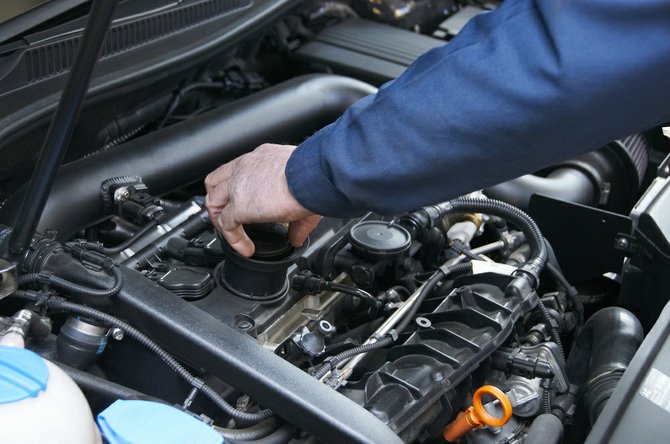 Maintenance schedules offered by car manufacturers always include the transmission. As stated earlier, transmission fluid plays a critical role in how a transmission functions and the car part longevity. Like engine oil, transmission fluid should be checked and changed on a regular basis; however, the interval is different for all vehicles and dependent on the transmission and fluid type as well as use.
Maintenance schedules offered by car manufacturers always include the transmission. As stated earlier, transmission fluid plays a critical role in how a transmission functions and the car part longevity. Like engine oil, transmission fluid should be checked and changed on a regular basis; however, the interval is different for all vehicles and dependent on the transmission and fluid type as well as use.
Most experts feel severe use warrants a recommended 15,000-mile (24,140-kilometer) fluid and filter change interval. Severe use is defined as more than 50 percent use in heavy city traffic with ambient temperatures above 90 degrees Fahrenheit (32.2 degrees Celsius) Remember the correlation between heat and lifespan? Experts also recommend changing the fluid whenever there is an indication of oxidization or contamination. Some transmissions, including a few models used by General Motors (GM), use an aluminum valve body. This soft metal is less tolerant of dirt and abrasives and GM recommends more frequent fluid changes to prolong the life of this auto part.
Hydraulics
An automatic transmission is essentially a large and complex hydraulic circuit. Each design creates a different circuit, but each works in what amounts to the same fashion. Any hydraulic system has the same basic components:
- Liquid
- A pump
- Lines to carry the liquid
- Control valves
- Output device
The primary physical law behind the automatic transmission was defined by the French scientist Blaise Pascal more than 300 years ago. He discovered liquids could readily transfer force because they were non-compressible. More importantly, force moving via a liquid could be transferred in a more flexible manner. Pascal also found the force applied to a liquid, thereby creating pressure, could be modified to create a mechanical advantage. This meant small amounts of force within a hydraulic circuit could be translated into large amounts of force. This can be seen in things like hydraulic jacks where one human being can raise several tons by applying hydraulic forces. It can also be seen in car brakes where a person's foot can apply enough force to stop a one-ton car moving at highway speeds. It's all hydraulic force, and it's all due to fluid.
Changing transmission fluid is not as simple as changing engine oil and should be handled by a service technician or someone with a thorough understanding of transmissions. Generally, the car is lifted on a hoist, the pan is dropped and the old fluid pours out. This fluid and the pan are inspected for contaminants, such as fiber from clutch discs or any other indication of a larger issue that may be appearing. After a routine check of the exposed components the filter is changed, the pan is replaced and the fluid added to the proper level.
Manual transmission fluid change is usually simpler. Manual transmissions are usually outfitted with drain and fill plugs. The car is lifted, the oil drained, and then refilled with the proper grade specified by the manufacturer. If an owner decides to tackle this operation on his or her own, one thing to remember is to make sure the fill plug can be removed and the fill tube is clear before draining.
While periodic fluid changes are ideal, checking the fluid level and condition on a regular basis is a good idea as well. Most automatic transmissions have a dipstick similar to the engine oil dipstick. However, unlike engine oil, the car must be running to check the level. The vehicle manual will also specify if the car should be in park or neutral, and what temperature the transmission should be -- fluids expand with temperature and checking a cold transmission will often provide a false reading. When the dipstick is out, smell the fluid and note if it smells burned (a symptom of overheating), or like any other fluid (gas, coolant or motor oil), which may be a symptom of a leak in the system or contamination. Also, wipe some of the fluid onto a piece of white paper or cloth and check the color against a fresh fluid sample. Too much variation in color could mean contamination or degradation of the fluid.
Manual transmissions can be checked by opening the filler plug. The level should be just below this hole. Dip a cotton swab in, pull some fluid out, and smell it to check the condition of the oil just as you would on an automatic transmission.
Some newer transmissions, including the Chrysler NAG1, don't offer dipsticks for routine checks. Instead a technician has a special dipstick used in conjunction with a chart and an electronic scan of the transmission temperature to determine the proper level. Other manufacturers, including GM, have sealed transmissions that are only serviceable by trained technicians with the correct tools.
While maintenance is key to auto part longevity, being aware of any bangs, whines or groans from the transmission, as well as smells, will help head off any problems at an early stage.
When it's time to service your transmission, call us (480) 619-5529 or (480) 985-2435



